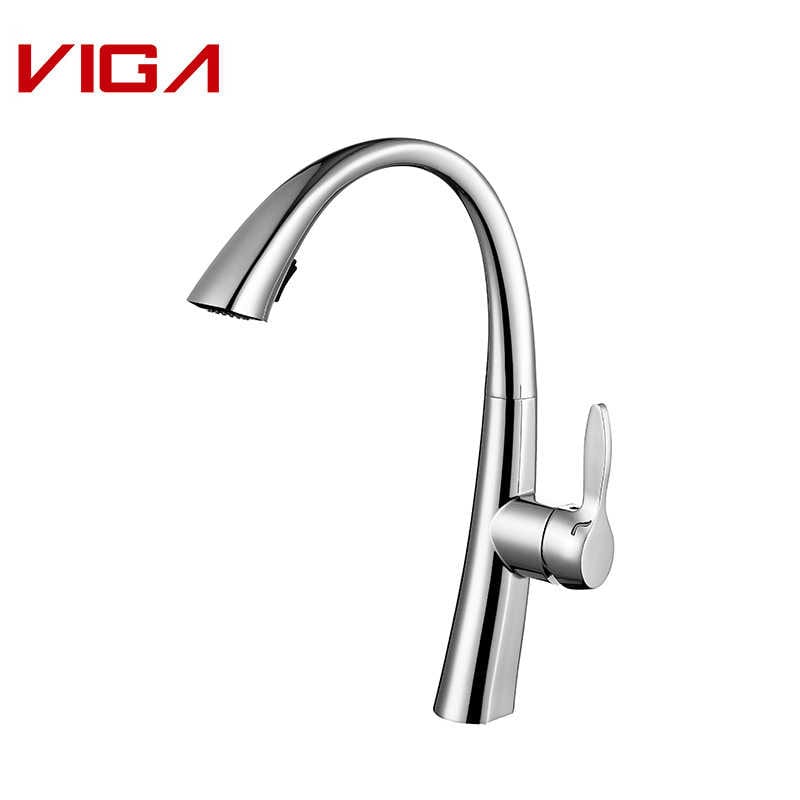Kitchen faucets date back to the ancient times and therefore have a long history of keeping water conveniently accessible for many homes.
The kitchen faucet is probably the most used feature in any kitchen. An average family is estimated to press the tap more than 40 times a day. That’s according to a report by KWC company. So it only makes sense that one should think of the kitchen faucet more thoughtfully, including how to choose the right one for your kitchen style, lifestyle and how to make it last through the years.
A typical faucet may last a decade or longer. The first to give out would be the finish while plastic and zinc give out in just five years. Make sure you make your kitchen faucet last longer by preserving the finish and by not using abrasives or ammonia.

The Ancient Romans in the 1000 BC used silver faucets. In 1700 BC, the Minoan Place of Knossos, held a terra cotta piping that pumped water into fountains. In the Middle Ages, kitchens were the central part of the home and almost everything revolved around it. In 1845, the first screw down tap mechanism was made by Gust and Chimes.
In 1937, a man named Alfred Moen invented a single-handed faucet that blended cold and hot water before it exited the “fixture.” He came up with the idea after burning his hands with a two handle convectional faucet, one for cold and one for hot. He thought that there should be a way to get what you wanted out of a faucet. Akauya nedzidziso yekudzora tembiricha nehuremu hwemvura panguva imwe chete mupombi imwe chete yekubata. Akaramba achigadzira pombi kubva 1940 ku 1945 ndokubva atengesa pombi yake yekutanga ine ruoko rumwe chete 1947. By 1959, dzose dzepombi dzine ruoko rumwe dzakanga dziri mudzimba dzinenge dzose.
In 1945, Landis H. Perry, yakagadzira yekutanga bhora vharafu iyo yakabatanidza vhoriyamu uye kusanganisa kwechisimbiso chiri nyore. Yakaita kuti faucet ishande zvakanyanya. Perry akatengesa patent yake kuna Alex Manoogian uyo, mukudzosa, akagadzira iyo Delta faucet mukati 1954. Iyi faucet yakabatanidza mazano uye faucet yaive yakarova. In 1958, kutengesa kweDelta faucet kwakasvika $1 mamiriyoni.
Muma1970, dhisiki rakagadzirwa neceramic rakagadzirwa neWolvering Brass iro raibatsira kudzora kuyerera kwemvura. Kubva ipapo, dhisiki yakashandura kashoma kuti iwedzere kupikisa uye kushanda.
Nhasi, we have the ability to pull out sprays and electronic faucets that were made by a various group of inventors. The fact that the kitchen faucet came this far in such a short time only shows it will continue to develop in the future.
Facts
- According to Gale Research, “A faucet is a device for delivering water from a plumbing system. It can consist of the following components:spout, handle(s), lift rod, cartridge, aerator, mixing chamber, and water inlets. When the handle is turned on, the valve opens and controls the water flow adjustment under any water or temperature condition. The faucet body is usually made of brass, though die-cast zinc and chrome-plated plastic are also used.” and “faucets come in a wide range of styles, colors, and finishes. Ergonomic designs may involve a longer spout length and easier to operate handles. The shape of the faucet and its finish will affect the manufacturing process. Some designs will be more difficult to machine or forge than others. A different finishing process may be used to achieve a different look.”
- Faucets are made to turn on and off the water, control the water temperature and provide a fast and efficient means to obtain water in the kitchen.
- Faucets are made to save time and energy. The lower the water flow rate, the more energy the faucet can save.
- According to Will Ford and Kitchen Faucet Center, “In a household full of 4 people, faucet water is about 18% of the water consumption which is a lot to say the least. Over the course of a year, the average household uses between 6,600-9,750 marita emvura pagore.”
- Maererano neWaterSense, pombi inodonhedza inodonhedza pamwero wekudonhera pasekondi imwe inogona kutambisa kupfuura 3,000 marita pagore. Imba ine zvimbuzi zveWaterSense yakanyorwa inogona kushandisa mvura iyoyo kugezesa kwemwedzi mitanhatu!
- Avhareji yemhuri yeAmerica inoshandisa avhareji ye 140 marita emvura pazuva.
- Maererano nepombi yemvura, "low-flow aerators anochengeta mwero wekuyerera pa/pazasi pe federal standard ye 2.2 gpm, zhinji dzepombi dzepamba pako dzinoshandisa mvura shoma. Asi nekuda kwekushandisa kwavo kwakanyanya, vanogona kuverengera kusvika 20% yekushandiswa kwemvura mumba zuva nezuva. Imba yakajairika inodhonza chero kubva pa18-27 galoni pazuva kubva kumapombi avo, kusanganisa kushandiswa kwese kwepombi kubva pakugeza maoko kusvika pakubika. Bear in mind that faucets without aerators — usually kitchen or laundry faucets — can have flow rates beyond 3 gpm, which wastes a lot of water.”
Statistics
- According to a 2014 Government Accountability Report,“40 out of 50 state water managers expect water shortages under average conditions in some portion of their states over the next decade.”
- According toUSA EPA, “Turning off the tap while brushing your teeth can save 8 gallons of water per day and, while shaving, can save 10 gallons of water per shave. Assuming you brush your teeth twice daily and shave 5 times per week, you could save nearly 5,700 marita pagore. Letting your faucet run for five minutes while washing dishes can waste 10 gallons of water and uses enough energy to power a 60-watt light bulb for 18 hours.”
Mitengo
The prices on faucets vary. They can be determined through material, design, function, and mobility. It’s up to the consumer to decide which type would be the best fit for their home. Installation also comes into consideration when determining the price. Here is a brief example of how prices can vary:
“Many water providers give low-flow aerators out to their customers for free or you can purchase one at many home improvement stores for about $1-5.00 each.”
 iVIGA Tap Factory Supplier
iVIGA Tap Factory Supplier
